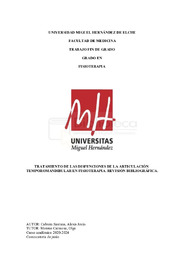Please use this identifier to cite or link to this item:
https://hdl.handle.net/11000/33529Full metadata record
| DC Field | Value | Language |
|---|---|---|
| dc.contributor.advisor | Moreno Carmona, Olga | - |
| dc.contributor.author | Cabrera Santana, Alexis Jesús | - |
| dc.contributor.other | Departamentos de la UMH::Patología y Cirugía | es_ES |
| dc.date.accessioned | 2024-10-16T12:11:32Z | - |
| dc.date.available | 2024-10-16T12:11:32Z | - |
| dc.date.created | 2024-05-31 | - |
| dc.identifier.uri | https://hdl.handle.net/11000/33529 | - |
| dc.description.abstract | Introducción: la articulación temporomandibular (ATM) contiene un disco articular que permite realizar movimientos que facilitan el habla, la deglución y la masticación. Cuando se ve afectada disminuye el rango de movimiento de la mandíbula, manifiesta dolor en los músculos masticatorios y en la articulación, ruidos articulares durante el movimiento y limitaciones funcionales. Normalmente se ve afectada la población entre 20-40 años, padeciéndola entre el 20 y 25% de la población total. La fisioterapia es una intervención conservadora muy frecuente para tratar esta patología y devolver su funcionalidad. Objetivos: conocer y aportar información actualizada de los mejores tratamientos fisioterapéuticos para las patologías de la ATM. Además, comprobar y observar qué tratamiento es eficaz para reducir el dolor, aumentar el ROM mandibular y aumentar la calidad de vida de los pacientes Material y métodos: búsqueda bibliográfica en diferentes bases de datos científicas: Pubmed, PEDro y Cochrane Library, incluyendo un total de 16 artículos. Resultados: los artículos han utilizado métodos como el TENS y el MENS, ejercicios de relajación post-isométrica (PIR) y de liberación miosfacial, tratamiento de LLLT (terapia láser de bajo nivel), terapia manual (MT) y punción seca, demostrando que estas intervenciones son eficaces. Conclusiones: la fisioterapia es una herramienta eficaz para tratar patologías de la ATM de forma conservadora y así, mejorar la calidad de vida. Aunque se necesitan estudios con una mayor población a estudiar para verificar las intervenciones fisioterapéuticas más efectivas, estos estudios muestran resultados positivos. | es_ES |
| dc.description.abstract | Introduction: The temporomandibular joint (TMJ) contains an articular disc allowing movements that facilitate speaking, swallowing and chewing. When it is affected, the range of motion of the jaw decreases, there is pain in the chewing muscles and the joint, joint noises during movement and functional limitations. Normally, the population between 20-40 years old is affected, with between 20 and 25% of the total population suffering from it. Physiotherapy is a very common conservative intervention to treat this pathology and restore its functionality. Objectives: know and provide updated information on the best physiotherapy treatments for TMJ pathologies. In addition, check and observe which treatment is effective in reducing pain, increasing mandibular ROM and increasing the quality of life of patients. Material and methods: bibliographic search in different scientific databases: Pubmed, PEDro y Cochrane Library, including a total of 11 items. Results: Articles have used methods such as TENS and MENS, post-isometric relaxation (PIR) and myosfacial release exercises, LLLT (low level laser therapy), manual therapy (MT) and dry needling, demonstrating that these interventions They are effective. Conclusions: Physiotherapy is an effective tool to treat TMJ pathologies conservatively and thus improve quality of life. Although studies with a larger population are needed to verify the most effective physiotherapy interventions, these studies show positive results. | es_ES |
| dc.format | application/pdf | es_ES |
| dc.format.extent | 36 | es_ES |
| dc.language.iso | spa | es_ES |
| dc.publisher | Universidad Miguel Hernández | es_ES |
| dc.rights | info:eu-repo/semantics/openAccess | es_ES |
| dc.rights | Attribution-NonCommercial-NoDerivatives 4.0 Internacional | * |
| dc.rights.uri | http://creativecommons.org/licenses/by-nc-nd/4.0/ | * |
| dc.subject | Articulación temporomandibular | es_ES |
| dc.subject | Trastorno de la articulación temporomandibular | es_ES |
| dc.subject | Modalidades de Fisioterapia | es_ES |
| dc.subject | Fisioterapia | es_ES |
| dc.subject.other | CDU::6 - Ciencias aplicadas | es_ES |
| dc.title | Tratamiento de las disfunciones de la articulación temporomandibular en fisioterapia. Revisión bibliográfica | es_ES |
| dc.type | info:eu-repo/semantics/bachelorThesis | es_ES |

View/Open:
TFG CABRERA SANTANA, ALEXIS JESÚS.pdf
1,09 MB
Adobe PDF
Share:
.png)
